About Our Work
Presidential Transitions, FDR-Present
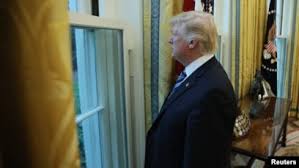 “There’s nothing that can completely prepare you for the job of being President… You know, that first day after…they walk you into the Oval Office, then everybody leaves, and you’re thinking, ‘Oh man, now what?!’
“There’s nothing that can completely prepare you for the job of being President… You know, that first day after…they walk you into the Oval Office, then everybody leaves, and you’re thinking, ‘Oh man, now what?!’
— President Barack Obama, 2016
A letter to the White House Transition Project:
“You were a big help to the Transition Coordinating Council and the overall transition effort both in 2001 and 2008. Thank you for taking the time to share your expertise.”
–- President George W. Bush, 2010
Since 1997, the White House Transition Project has provided non-partisan expertise in all phases of democratic transitions, from constitution-building in emerging democracies to regularized, statute driven transfers of power. This page previews those services, highlighting our White House office “briefs” compiled from hundreds of interviews with former White House staff about their preparations, work routines, mistakes, and successes.
WHTP Updates
| New Resources at WHTP |
WHTP’s Director’s Research on Press Relations. Read stories from The AP in the Washington Post and another story in the The London Times. Reports on the 100 Days Stand Up – Two reports on the Trump 47 stand up. One on press relations and one on appointments. Government Resources – Reports from Government Agencies and Congressional resources related to practices and routines associated with presidential transitions. The newest resource covers:
|
WHTP’s Transition Resources
| WHTP provides a range of resources to campaigns, reporters, and scholars. Click on each for a preview. |
Institutional Memory – Briefs describing practices and routine for critical White House offices compiled from two decades of interviews with former presidential assistants from the Nixon presidency onward. Work Life Studies – General essays on what makes working in a White House special and so challenging for its staff, based on two decades of interviews with former presidential assistants from the Nixon presidency onward. Following the Transition – scholarly reports on the transition process as it proceeds. WHTP Public Events – Transcriptions of numerous WHTP public events. |
WHTP’s Institutional Memory Briefs
After interviewing hundreds of former White House aides, WHTP has built briefing books on 13 White House offices. These briefs summarize best and worst practices for those who have worked in these offices, office routines, work life, etc. Below, see a couple of examples and then…
see all of our briefs here.
OMB – an Insider’s Guide
Life in OMB is not in the fast lane. Life in OMB is in the oncoming lane.
— Former Director OMB Jim Miller
The joint product of 21 former senior OMB leaders, the WHTP briefing book on OMB offers a unique view on this critical executive agency and what it takes to run it. Many agree that the requirements for leadership at OMB are far different than what many in Washington expect — having experience in the congressional budget process, for example, is widely agreed upon as not one of them. Not unexpectedly, many in Washington simply don’t understand what it takes to lead at OMB and carry through on the President’s mission. To get your own copy of the guide, click here.
The Chief of Staff, in Brief
This synopsis summarizes the WHTP briefing book on the White House Chief of Staff, click here.
Office of the Chief of Staff, in full
In the end, every chief of staff is a servant of the president, and the more independence they ask for or try to carve out for themselves, the more likely they are to fail.
It once was possible to argue that the White House could be run without a chief of staff. Those days are gone. The complexity of the modern White House requires discipline and coordination that can only be achieved if there is a central coordinating point, someone other than the president to oversee the operation. If independence and authority are both the necessity of a White House and a recipe for failure, then how do White House Chiefs of Staff proceed. This new brief brings the wisdom of experience to bear on this question from the advice of those who have borne the responsibility. Click here for a copy.
Office of the Vice President
Once the epitome of a spare part, the Vice Presidency has become a central element of every administration’s successes or failures.
“Two brothers went off to make their fortunes. One went to sea and the other became Vice President. Neither was ever heard from again.” No other job in the American constitutional system has seen a greater transformation than the Office of the Vice President. This briefing book on the vice-president outlines the dimensions of that change and how to manage the opportunities and responsibilities of this newly defined position in the White House.
See all of briefs here.
Back to the top.
Useful Tools: WHTP’s White House Organization Charts
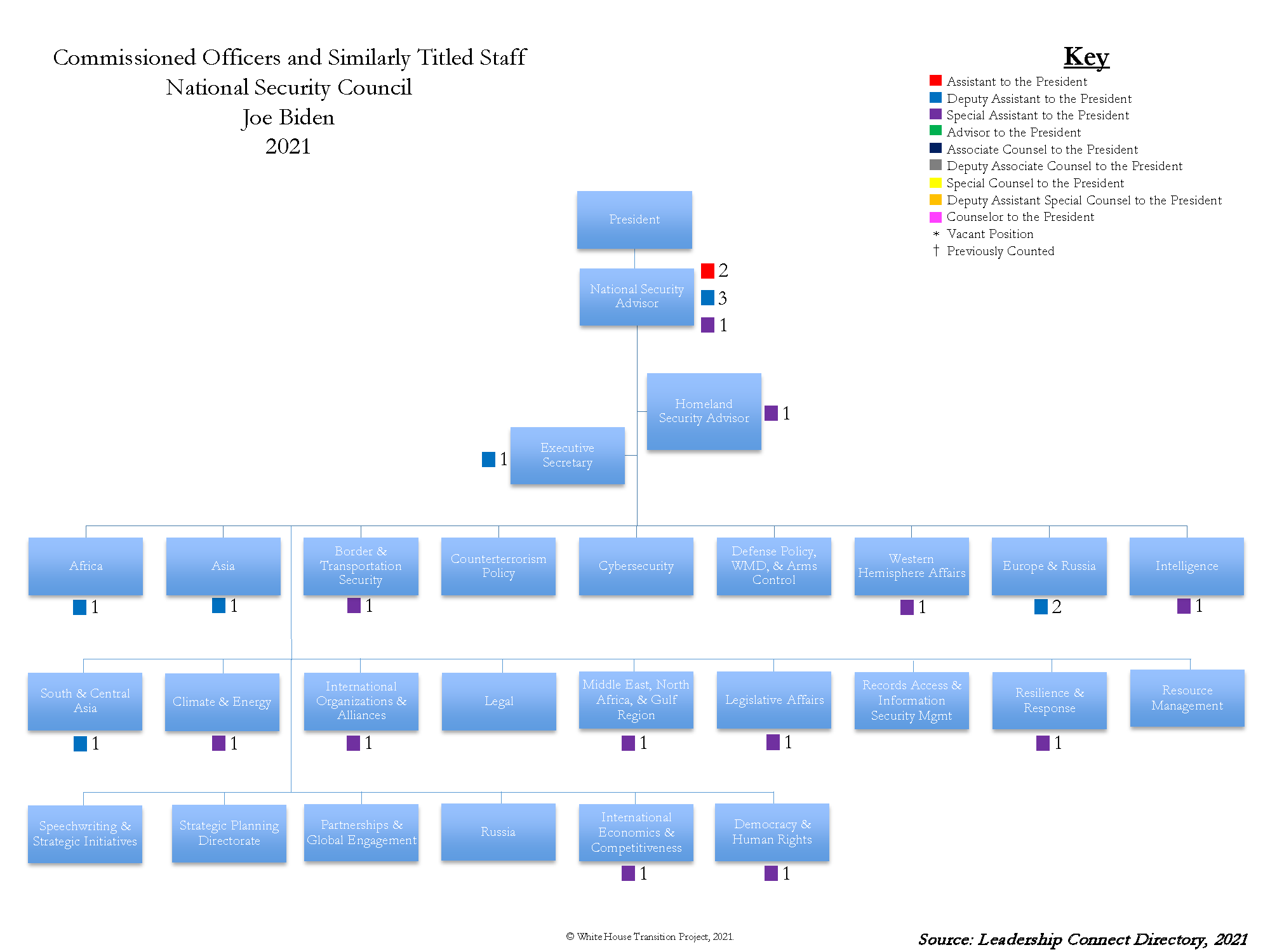 A part of its long standing program, the White House Transition Project compiles staffing patterns through its White House organization charts. Part of that exclusive series, the current document covers the initial organization of the Biden 2021 White House Office, the Vice President’s Office, the First Lady’s Office, and the NSC.
A part of its long standing program, the White House Transition Project compiles staffing patterns through its White House organization charts. Part of that exclusive series, the current document covers the initial organization of the Biden 2021 White House Office, the Vice President’s Office, the First Lady’s Office, and the NSC.
Click here for the full collection of organization charts for other administrations and other offices.
Back to the top.
Following a Transition
Back to the top.
This section of our website regularly publishes special and timely studies of the transition process, including those covering legal elements of the process, planning documents, along with studies of the transition in progress, with reports on topics for which WHTP has special scholarly expertise, e.g., appointments, press relations. Here are some examples:
The Transition’s Path
“Thanks to the decades long work of many private organizations, like the Baker Institute and the White House Transition Project, we now have a useful map for readying the peaceful transfer of power.”
— James A. Baker III, former White House Chief of Staff, Secretary of Treasury, and Secretary of State
At the end of the twentieth century, non-profits engaged in a number efforts highlighting the need for more early preparations for the peaceful transfer of power, especially among those most likely to take on the responsibilities for governing that fall on the White House staff. After nearly two decades of work, the US government has taken a number of steps to extend and regularize early preparations among the national campaigns and in the national executive and the White House. The two documents below outline what this new map for a peaceful transfer looks like:
| From the White House Transition Project: WHTP – 07 WHAT HAPPENS NEXT |
From the Congressional Research Service: On GSA Transition Services 2024-08-14-1 |
Start Early, Go Big – inside the 2021 Biden Transition
“Wonderful storytelling and sharp analysis. Required reading for anyone interested in how to run a transition and build a presidency.”
— Paul C. Light, Goddard Professor of Public Service, NYU
WHTP Director Martha J. Kumar wrote this study of the 2021 Biden Transition. Click here for the full report in PDF and click here for the official version generously made possible by Wiley publications. The abstract:
The 2021 transition will be remembered as the most tumultuous in over a century. President Trump sought to delegitimize the presidential election as flawed and refused to concede his loss, and several of his departments and agencies slow-walked their cooperation with the incoming team. The insurrection on the Capitol and the Trump impeachment trial brought more turmoil. How, in such an environment, did Joseph R. Biden manage to complete the basic transition preparations needed to get off to the fast and effective start his administration had? A presidential transition has two dominant threads that come together to pave the path to a productive beginning. Early transition planning was aided by existing laws requiring the federal government to provide important elements to transition planning. Additionally, and somewhat unusually, Biden drew on people who had experience in government service.
Reports on the “Stand Up” at 100 Days
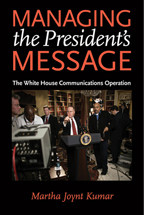 Trump and the Press. In this section, WHTP covers the Trump 47 stand up. Currently, this section presents two studies on the 100 days. The first report covers Trump 47 and press relations, written by Martha Kumar, a primary researcher on this topic and author of a number of studies, including Managing the President’s Message and Before the Oath. Her newest report covers press relations during the first 100 days of Trump II within the context of similar efforts by Presidents Reagan through Biden. One major finding: Trump doesn’t have a communications problem, he has a policy problem. Get a copy of the report here. You can also read about this research in the Washington Post and in the The London Times.
Trump and the Press. In this section, WHTP covers the Trump 47 stand up. Currently, this section presents two studies on the 100 days. The first report covers Trump 47 and press relations, written by Martha Kumar, a primary researcher on this topic and author of a number of studies, including Managing the President’s Message and Before the Oath. Her newest report covers press relations during the first 100 days of Trump II within the context of similar efforts by Presidents Reagan through Biden. One major finding: Trump doesn’t have a communications problem, he has a policy problem. Get a copy of the report here. You can also read about this research in the Washington Post and in the The London Times.
Trump’s Appointments. This 100 Days report summarizes five of the six measures of the new Administration’s progress in standing up the American Executive Branch. It covers, for the first quarter of the first 100 days, the general pace of nominations and confirmations, a recurring focus on gender, and a summary of the backlog of confirmations. Click here for additional information on what research tells us about the patterns of appointments.
Back to the top.
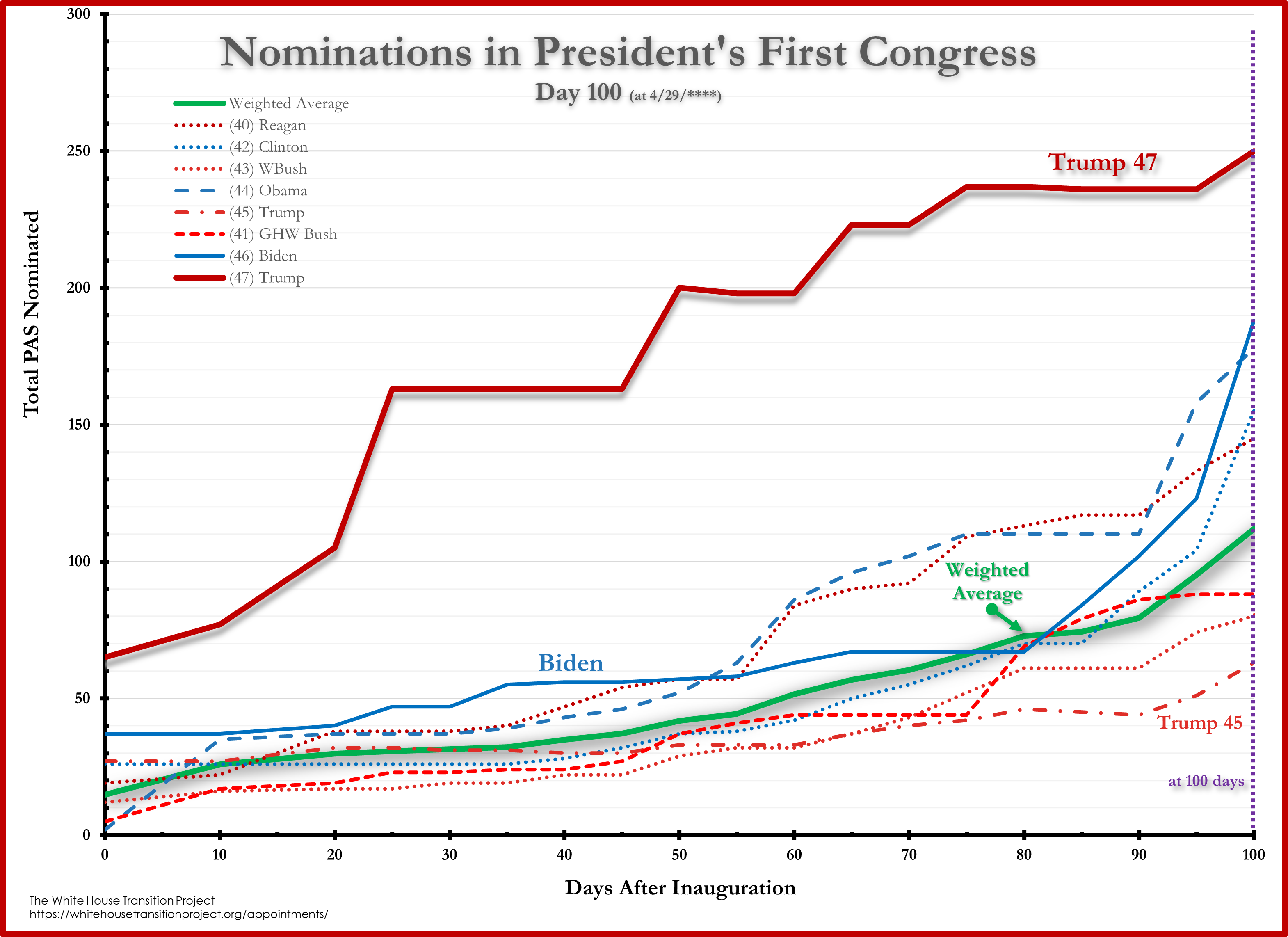 Naming the Administration – Still Tracking Well Ahead of Everyone
Naming the Administration – Still Tracking Well Ahead of Everyone
It continues to look like the early planning for appointments and all of the vetting during the campaign led to a record-setting pace of presidential nominations. As they end the first 100 days, Trump 47 has produced a record well beyond his predecessors.
Back to the top.
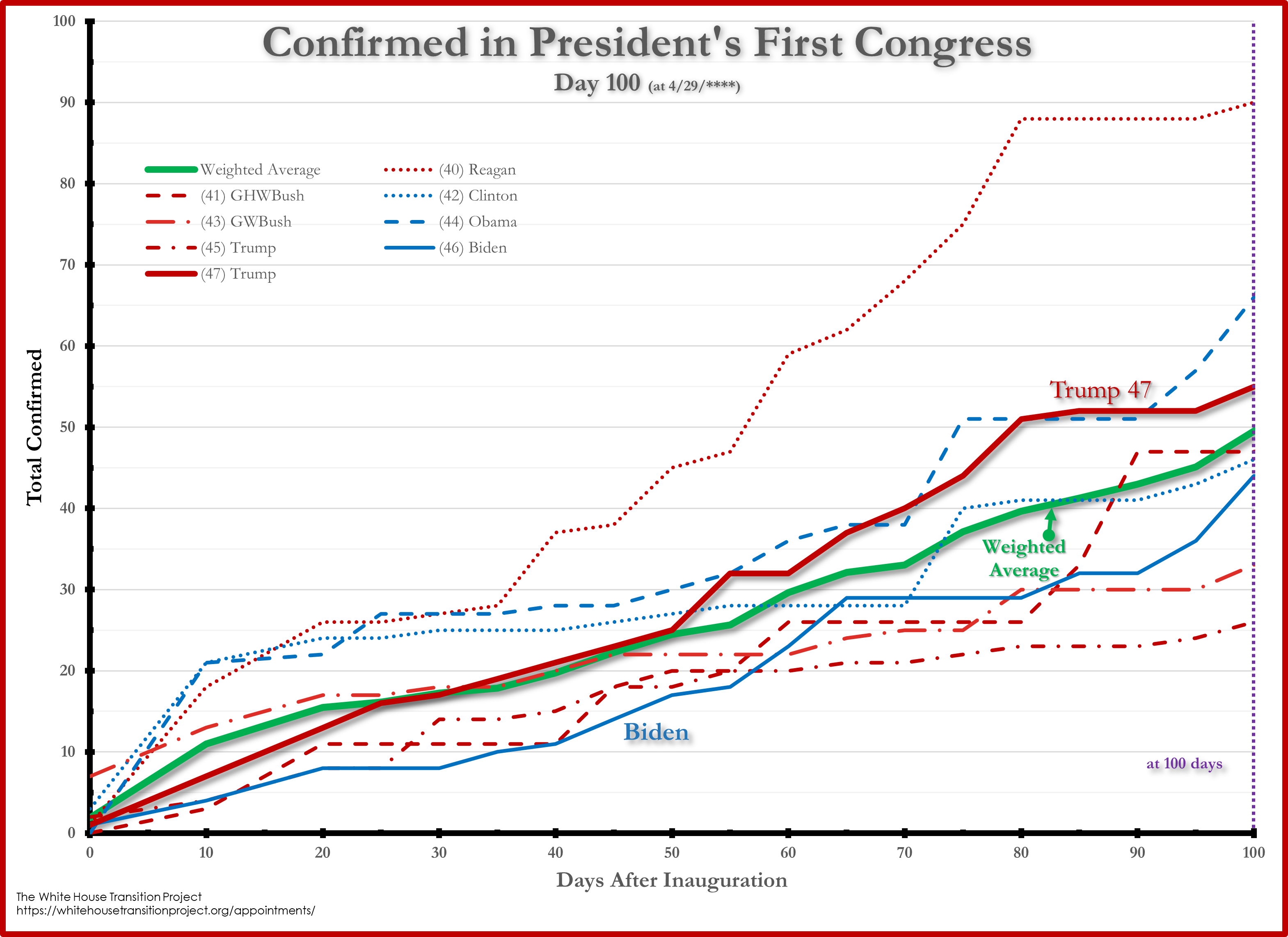 Confirming nominees – The Senate maintains a reasonably strong pace.
Confirming nominees – The Senate maintains a reasonably strong pace.
Since the beginning of the modern appointments system (beginning with President Reagan’s tenure), Senate majorities have maintained a seemingly slow confirmation process, reflecting a number of standard deficiencies. For example, only two committees maintain a staff designated exclusively for Advice and Consent — to process and evaluate nominees. One of the two, Judiciary, has had few nominees yet to process (nominees for the Federal Judiciary typically begin around the beginning of April). Despite these natural deficiencies, the Trump 47 Senate has moved at a pace slightly ahead of the average for previous administrations. Presidents Reagan and Obama saw a faster confirmation pace at the 100 days point.
Back to the top.
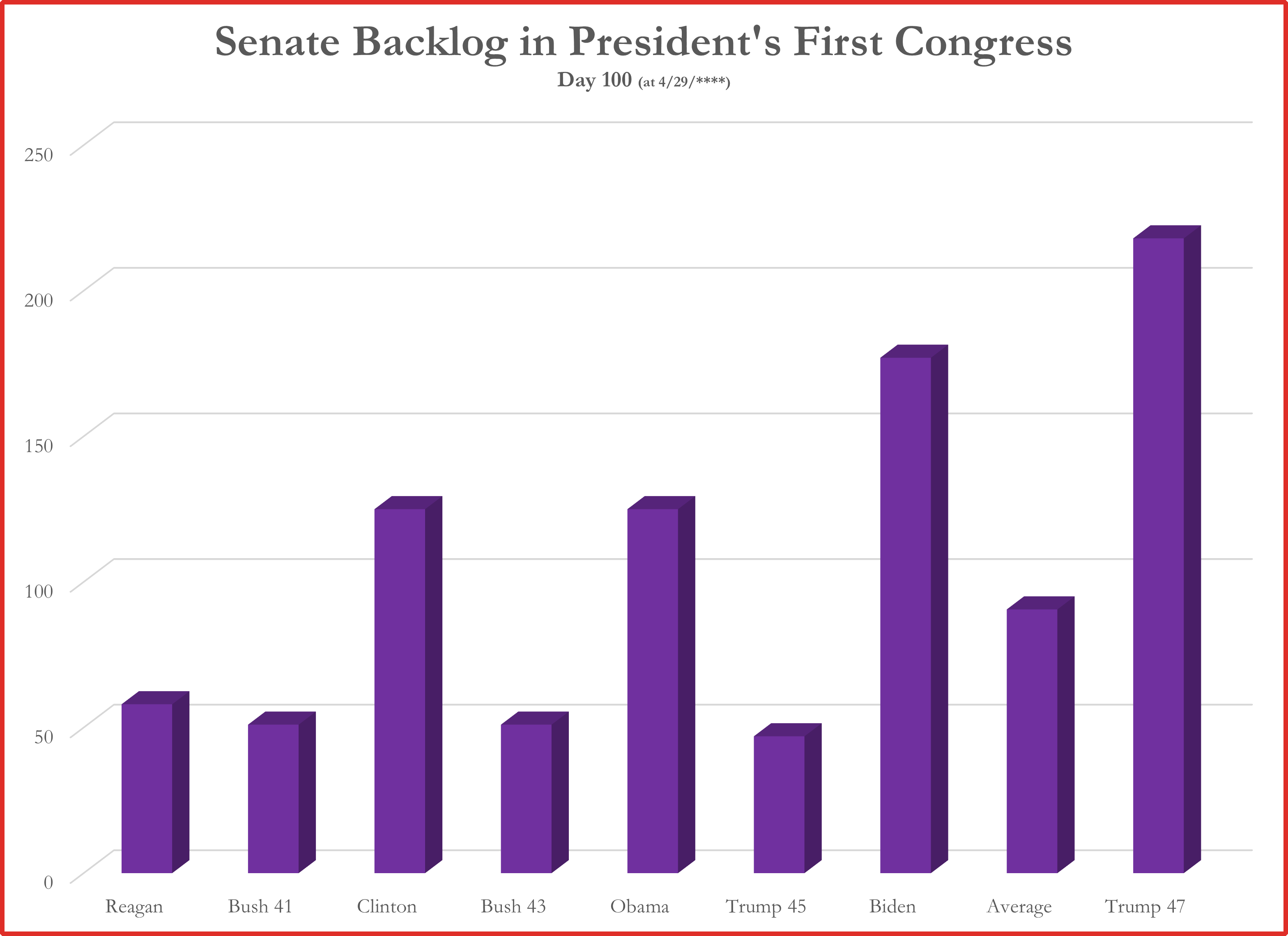 The Backlog – The Senate continues to face a record backlog.
The Backlog – The Senate continues to face a record backlog.
At the 100 day mark, the Senate continues with a backlog of nominations ten times greater than the average. The backlog results from the confluence of record setting nominations meeting the under-resourced Senate processes (see the WHTP summary of the research scholarship on the topic, below).
Back to the top.
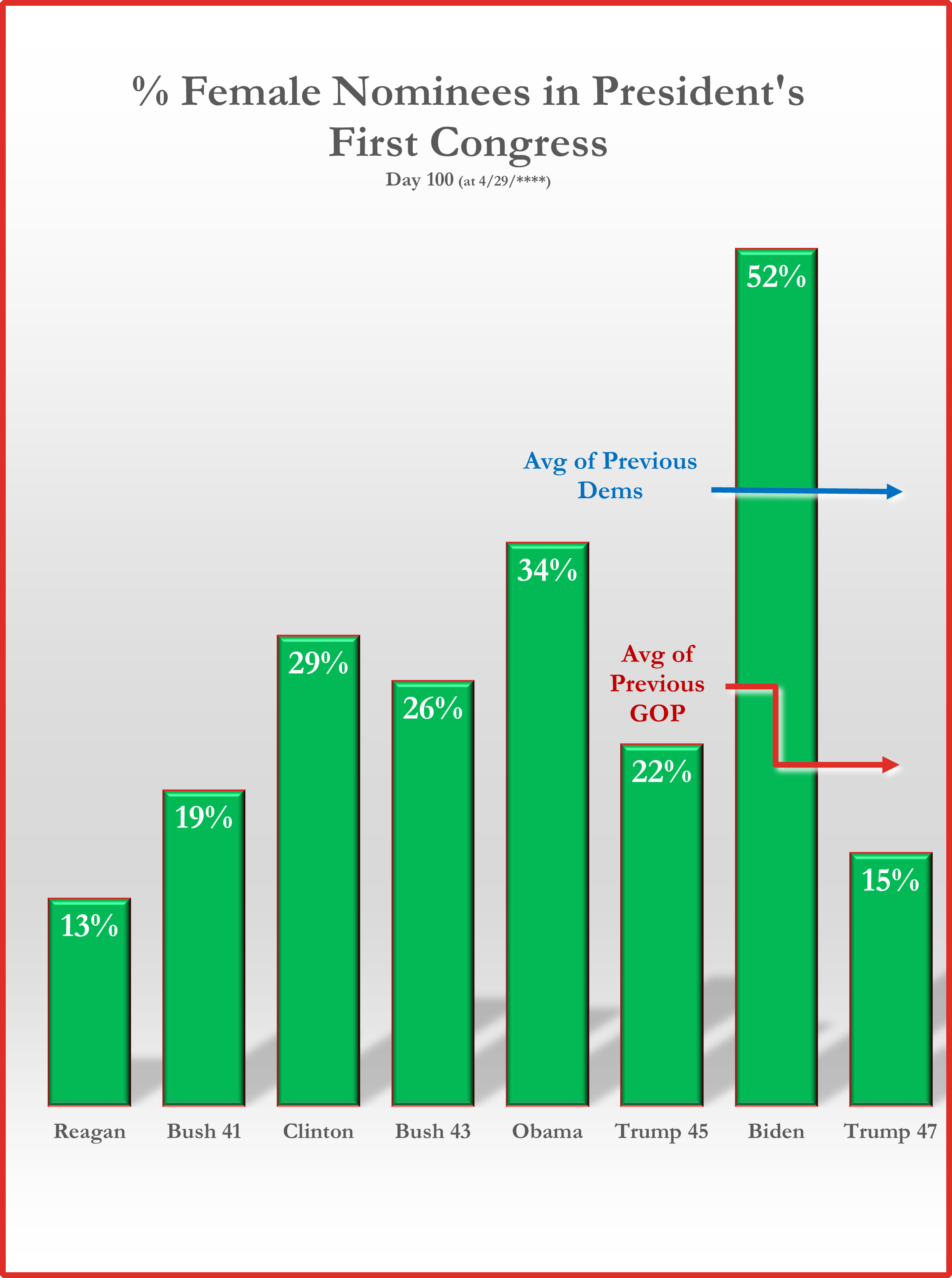 The Gender Rate – No Diversity Here.
The Gender Rate – No Diversity Here.
On the basis of gender (or even “sex”), the massive number of early Trump 47 nominations has produced the second smallest proportion of women nominees than that of the nominations of all but one predecessor (including even Trump 45) in the modern appointments era (excepting for President Reagan).
At 15% of the Trump 47 nominees, this rate represents only 30% of the Biden pace. It also fails by three quarters to reflect the distribution in the US population — 51%. It even represents 25% less than the average rate for just Republican predecessors while under the average for Democrats by nearly 60%. Assuming the Congress goes along with the Trump commitment to terminate the Department of Education, the rate for women would drop to the lowest of all presidents in the modern appointments process, even lower than that of President Reagan in 1981. These early Trump nominations, if confirmed, will produce a presidential administrative team of almost entirely white men.
Back to the top.
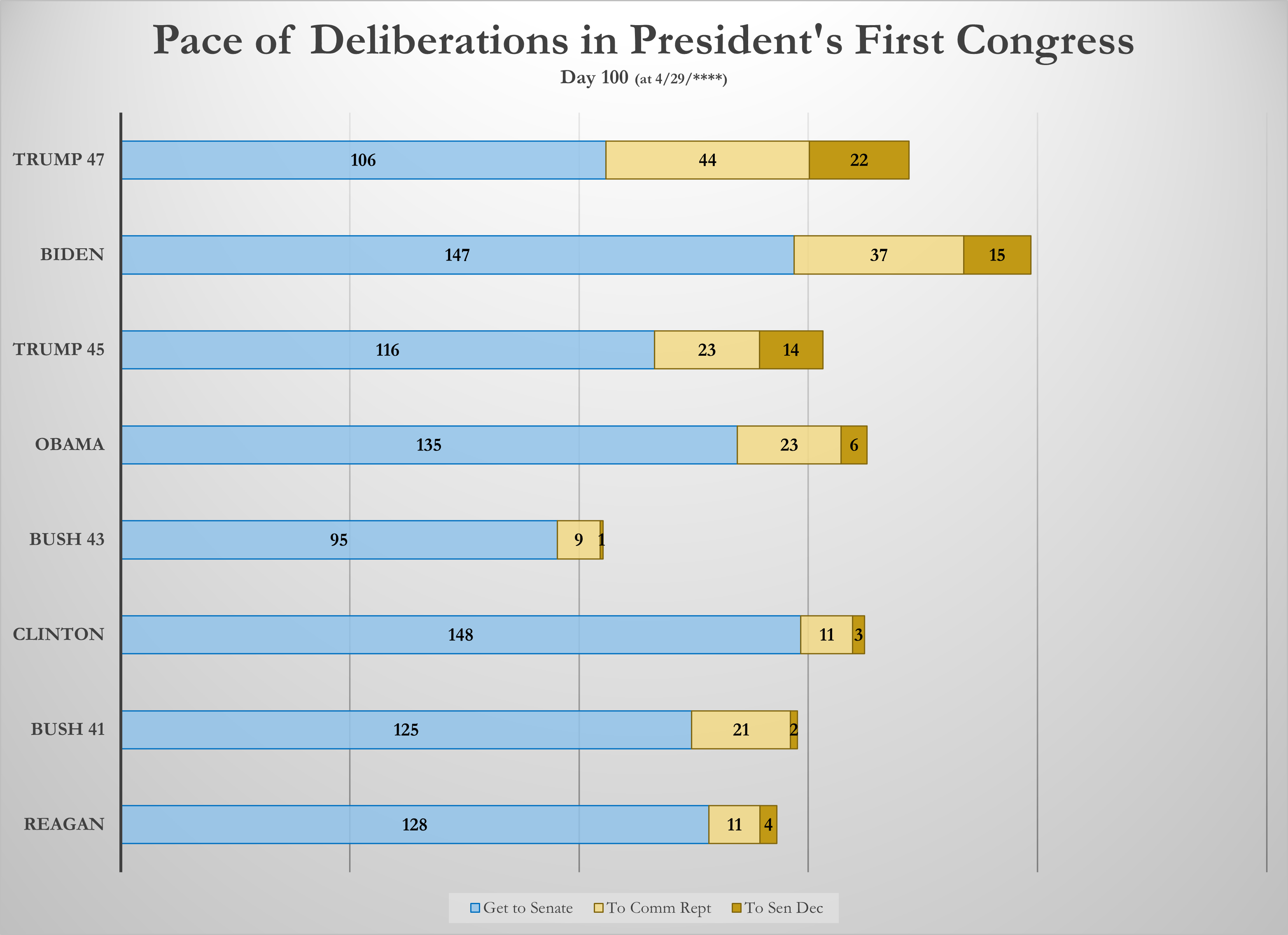 The Pace of Deliberations – At each stage in the appointments process, how long does it take to complete appointments? This study produces something of a picture of where delays originate. The overall pace reflects the common pattern of an ever lengthening appointments process. The pace of Trump 47 Senate deliberations leading to a Senate confirmation mirrors the experience of the Biden administration and extends the Reagan experience 4.5 times. The largest proportion of the process however still remains on the White House side.
The Pace of Deliberations – At each stage in the appointments process, how long does it take to complete appointments? This study produces something of a picture of where delays originate. The overall pace reflects the common pattern of an ever lengthening appointments process. The pace of Trump 47 Senate deliberations leading to a Senate confirmation mirrors the experience of the Biden administration and extends the Reagan experience 4.5 times. The largest proportion of the process however still remains on the White House side.
Back to the top.
Remaining Appointments Studies to Come
The Pace of Agency Standup – The Level of leadership staffing by Cabinet agency. Too early to produce a realistic picture.
Details of a Peaceful Transition
Back to the top.
Congressional Testimony on Presidential Transitions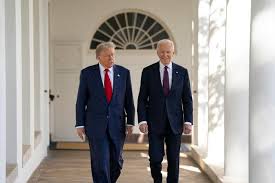 Since 1964, Congress and the President recognized then and continue to acknowledge the importance of an effective transition to a good start for a new President and his team. Having a well-organized operation developed early in the election year benefits a President. Organizing early with an experienced and knowledgeable staff, an incoming President can seize the political momentum and establish his brand of leadership at a time when the public is paying attention. See the complete testimony of WHTP Director Martha Joynt Kumar by clicking here. To view the actual testimony and committee hearing, click here.
Since 1964, Congress and the President recognized then and continue to acknowledge the importance of an effective transition to a good start for a new President and his team. Having a well-organized operation developed early in the election year benefits a President. Organizing early with an experienced and knowledgeable staff, an incoming President can seize the political momentum and establish his brand of leadership at a time when the public is paying attention. See the complete testimony of WHTP Director Martha Joynt Kumar by clicking here. To view the actual testimony and committee hearing, click here.
Presidential Activities During the 100 Days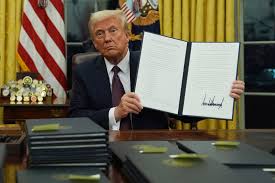 On day 1, new presidents step onto the thin ice of history, alone. What do they do all day, who do they see, and what choices affect both? A new report from WHTP answers these questions. Using detailed (often minute-by-minute) records on presidential activities, this study summarizes the distribution of time dedicated to different presidential responsibilities, including what presidents typically trade-off in one responsibility to increase their engagement in another. One clear trade-off constant over several decades: increased efforts at communications comes directly from a decrease in national security and diplomacy activites. The report also details which advisors regularly see the president and how White House organizational patterns affect advice. One clear pattern over several decades: the less control the Chief of Staff has over who “gets in the room,” the more isolated a president becomes. For a copy, click here.
On day 1, new presidents step onto the thin ice of history, alone. What do they do all day, who do they see, and what choices affect both? A new report from WHTP answers these questions. Using detailed (often minute-by-minute) records on presidential activities, this study summarizes the distribution of time dedicated to different presidential responsibilities, including what presidents typically trade-off in one responsibility to increase their engagement in another. One clear trade-off constant over several decades: increased efforts at communications comes directly from a decrease in national security and diplomacy activites. The report also details which advisors regularly see the president and how White House organizational patterns affect advice. One clear pattern over several decades: the less control the Chief of Staff has over who “gets in the room,” the more isolated a president becomes. For a copy, click here.
The Potential For Presidential Leadership
The challenge of a new transition inevitably involves how to lead. Now, more than ever, a new president will face that challenge. In an essay on how opportunity and persuasion shape the potential for leadership, renown presidential scholar George Edwards suggests “Staying private is likely to contribute to reducing gridlock, incivility, and public cynicism and deserves a more prominent role in the president’s strategic arsenal.” For a copy, click here.
WHTP’s Public Information Events
(as of 02/13/2025) No events currently planned.
Technical Aspects of Peaceful Transitions
The Role of an Inspector General
Find here a Congressional Research Service report on the laws governing the role of Inspector General, their appointment and removal. In particular, on their removal:
In most cases, Congress must receive advanced notice of an IG’s removal or transfer. The removal authority must communicate to both houses of Congress, in writing, the “substantive rationale” for the IG’s removal or transfer 30 days in advance for establishment, DFE, and special IGs—representing 68 out of 74 IGs. Additionally, this notice must include information on any “open or completed inquiry” into the IG being removed [5 U.S.C. §403(b)(1)(B)].
Advanced notice requirements for removal vary across other permanent IGs. Authorizing statutes for other permanent IGs in the executive branch require the same 30-day advanced written notice (including substantive rationale) but only to the congressional intelligence committees. Authorizing statutes for the other permanent IGs in the legislative branch do not explicitly require advanced notice and instead require written communication to Congress explaining the reason for removal [2 U.S.C. §1808(c)(2) (AOC IG); 31 U.S.C. §705(b)(2) (GAO IG); 44 U.S.C. §3902(b) (GPO IG); 2 U.S.C. §185(c)(2) (LOC IG); 2 U.S.C. §1909(b)(3) (USCP IG)].
Security Classified Documents in Transitions
Find here the President’s Task Force on Handling Presidential Records during the transition. It recommends improved guidance on handling records and better funding for appropriate spaces to review documents during the transition and afterwards.
Using the “Nuclear Option” slowed confirmations, …again
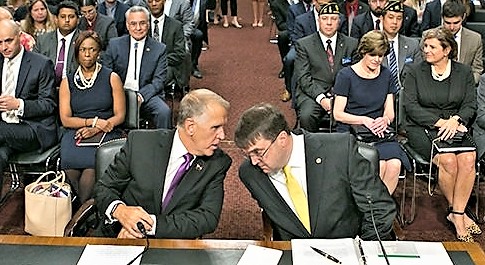 A new WHTP study analyzes deployments of the “nuclear option” to limit the filibuster, along with other Senate changes affecting deliberations on nominations (including limits on “blue slips”). Senate leaders of both parties intended these changes to promote faster consideration of the president’s judicial nominees. That hasn’t happen. Here’s why, what did happen, and how to strengthen the appointments process before the next time. The highlighted changes would actually reduce partisanship.
A new WHTP study analyzes deployments of the “nuclear option” to limit the filibuster, along with other Senate changes affecting deliberations on nominations (including limits on “blue slips”). Senate leaders of both parties intended these changes to promote faster consideration of the president’s judicial nominees. That hasn’t happen. Here’s why, what did happen, and how to strengthen the appointments process before the next time. The highlighted changes would actually reduce partisanship.
Back to the top.
Appointments Strategies
WHTP’s Research Summary on Appointment Politics outlines in memo form what research tells us about how to get ready for and then improve the appointments process, including how to limit the impact of growing partisanship.
Back to the top.
Senate Bill Proposes Appointments Dashboard
Senators Peters and Lankford have proposed a government wide approach to providing more information tracking presidential appointments with special emphasis on vacancies and acting appointments. Click here for a copy of the new bill.
Presidents and the Press
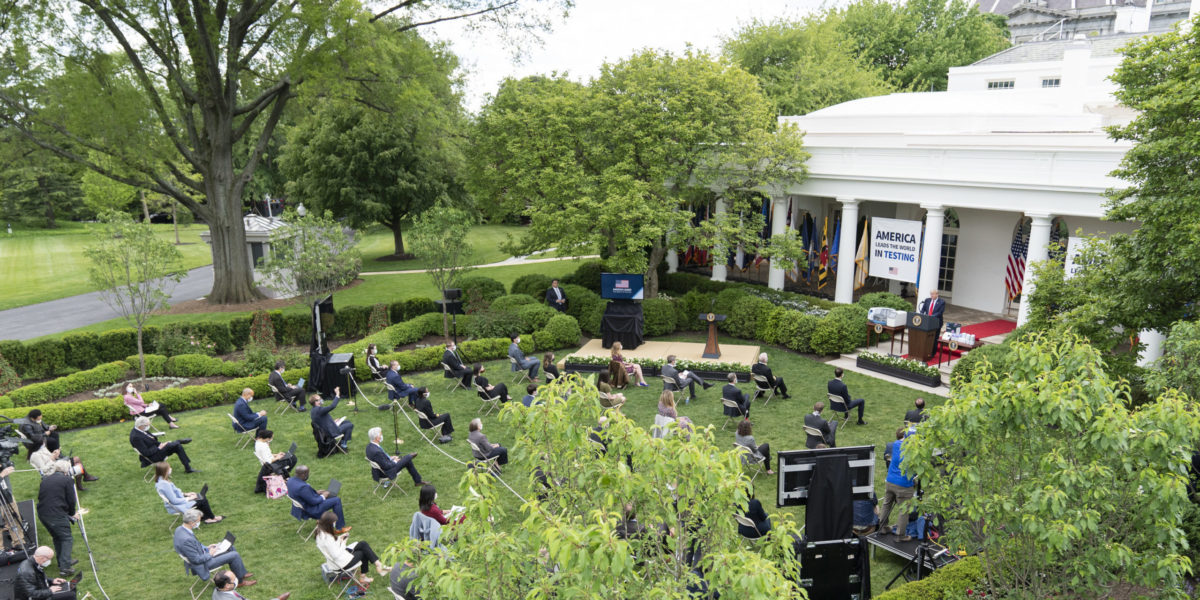 Biden in Comparative Perspective
Biden in Comparative Perspective
Using her unique data on press interactions, WHTP’s Martha Joynt Kumar compares President Joe Biden to his six predecessors showing how each used the communications strategies that brought them to the presidency. In that way, President Biden mirrors his predecessors. But in other ways, those six predecessors had more in common with each other, e.g., Biden answers more frequently, but he takes fewer questions than the average. See this analysis by clicking here.
Back to the top.
US Presidency Operations Research
Emerging Democracy Transitions |
US Constitutional Transitions |
WHTP’s Basic Transition Services
Since 1997, the White House Transition Project has interviewed a wide range of Assistants to the President about the best ways to carry out the president’s transition to governing and manage their responsibilities in governing. WHTP scholars who specialize in the various operations of a White House, use these interviews to provide a guide for the new presidential team.
Original Interview Foundations for Office Briefs
In addition to these basic resources for US Presidential Transitions, WHTP maintains a collection of its basic interview, through our long-standing partner, the US National Archives. For a sample of these interviews currently in the public domain go here.
Essays on Running Transitions
To adjust critical attitudes about presidential transitions, WHTP maintains a collection essays on how transitions work and how others have learned the lessons about how to prepare. See the drop down menu under the banner for general essays on transitions.
WHTP’s Original Research
To supplement our basic transition resources, WHTP maintains robust research agendas on topics of interest to the US Presidential transition and to normal White House operations. Some of these studies result from requests originating with previous White House staffs as they try to improve their governing operations. This section previews some of these studies.
Current WHTP Studies On Presidential-Press Relations
In one of our periodic reviews, Martha Joynt Kumar reviews presidential interchanges with the press over the last six presidencies and as of 30 months into their administrations. Read the report: Six Presidents Interchange’s with Reporters at 30 Months – Kumar. Some of the highlights:
- President Trump answers 50% more questions from the press than the average for the last five presidents.
- Presidents have expanded their press relations into forums they believe are their strong suit.
- While most presidents aim their communications to the average citizen, President Trump aims at his supporters alone.
Back to the top.
Current WHTP Studies on Presidential Work Routines
The use of time represents the president’s most valuable asset. A commitment to one responsibility necessarily precludes commitment to another. And as a president faces changed circumstances, changing commitments creates trade-offs between responsibilities. Using the daily minute by minute logs of presidents, WHTP builds a picture of typical presidential commitment and trade-offs. These studies focus on two topics: the transition period through to the 100th day and crisis management. See for example, Presidential Work in the First 100 Days.
Back to the top.
WHTP Reports on Presidential Appointments
The pace of appointments in both the executive and in the Senate accounts for the ability of any administration to carry out its responsibilities to the electorate and to the nation. Appointments fulfill the president’s agenda set by the election and they also stand up the critical functions of the national government, from transportation to space to global economics and national defense.
Our personnel trackers report on deliberations across the entire appointments process:
- WH Identifies: The White House search for appropriate nominees from available candidates. Typically, this stage culminates in an announcement of the “president’s intent to nominate” a candidate.
- Executive Review: The executive branch conducts vetting of the candidate. This stage culminates in sending credentials to the Senate as an official nominee.
- Sen Comm Vetting: The first of two Senate stages, a committee investigates the nominee, culminating in a committee report and recommendation to the full Senate.
- Sen Floor Process: The final disposition of a nominee in the Senate, culminating in floor vote to confirm the nominee.
WHTP’s Personnel Trackers follow the pace of appointments in the new administration by comparison with administration’s dating to the rise of the modern appointments system during President Reagan’s first year. The trackers cover two groups: a common set of 220 “critical” appointments and a larger, more diverse group of 980 presidential nominations.
WHTP reports these results in 10 day increments during the first two years. See our Appointments page for more detailed information.
Back to the top.
